German City Trips 2025
Fascinating Moments in Germany
Every year, I try to broaden my horizons by visiting new stunning places to explore the beauties of Germany. It's also amazing to come back to cities, I've been before, to immerse myself in the atmosphere of the city in a new season - like feeling the spring with all its beautiful blooming flowers in Karlsruhe and Konstanz. I don't always need to be far away from home. I just want to be in beautiful places and cities to keep having exciting adventures.
This year, the first city trip was a one-day journey to Karlsruhe. After we spent some time in Offenburg to enjoy the pre-Easter atmosphere on the weekend market, we finally took the train to Karlsruhe. For me, it was the second time visiting Karlsruhe after strolling through the city centre and Durlach in freezing temperatures last year in January. After we had strengthened ourselves in the Ettli Café with a delicious blueberry tiramisu and coffee, we continued our walk through the central market square with the pyramid until we reached the Karlsruhe Castle Garden. Here, we spent quite a while and enjoyed the various gardens before we found ourselves in a sea of flowers with magnificent colours and beautiful sunshine in the botanical garden. We enjoyed the moment a lot and decided to take it easy and reduce our plan for the day, since we planned to visit many more places this day. Afterwards, we only made it to the Günther-Klotz-Anlage, another beautiful area to relax with a small hill from which we could admire the entire park. We walked through the park and enjoyed the view of the lake, the forest and many cute ducks. There was also a possibility to rent a pedal boat, which we have planned for our next visit in Karlsruhe, combined with a little picnic. All in all, it was a wonderful trip to the Spring paradise of Karlsruhe.
Two weeks after our weekend trip to Amsterdam, we already had the next highlight in our minds - a visit of the flower island of Mainau, the third-largest island in Lake Constance, very close to the actual city of Konstanz. We set off early in the morning from Freiburg to spend as much time as possible on the island, and after a rather long journey by train and bus, we finally reached the island's entrance. Passing the Swedish Cross, which has adorned the shoreline between Mainau and the mainland for several centuries and dates back to the Swedish rule during the Thirty Years' War, we arrived on the island and immediately felt like we were in a flower paradise. Unlike Keukenhof, which stands out primarily for its wide variety of different tulips, Mainau is unique for its diversity and biodiversity, with many spectacular, different gardens, each of which was stunningly beautiful. After a short walk through the herb garden to the flower animals and the Mainau farm with a petting zoo, we arrived at the beautiful Dahlia Garden, where in spring, daffodils, Iceland poppies, forget-me-nots and tulips can be admired in the colourful sea of blossoms. The splendor of colour and the panoramic view of Lake Constance made this section to a unique experience. Just a few steps further, we spotted the Italian Flower Water Staircase, which elegantly connects the Mediterranean Terraces with the lower shore area and, together with the Mediterrean Terraces, creates a fantastic holiday atmosphere. The east side of Mainau shone in another splendor of colours, full of rhododendron bushes, a flowerbed shaped like Lake Constance and a flower butterfly with a view of the rhododendron garden. From here, we continued slightly uphill to the architectural heart of the island, the Mainau Castle with the adjacent Palm House and the romantic floral magic of the Italian Rose Garden. In the exotic Palm House, with its tropical atmosphere, we were able to snag one of the tables in the Schlosscafé for a short break with coffee and cake - and the cakes were excellent. After our short break, we were once again able to immerse ourselves in a whole new world full of impressive giant trees like the Metasequoia. The contrast between this avenue of dawn redwoods and the colourful gardens on the southern side of the island was also very exciting to see and culminated in another highlight - the Butterfly House with up to 120 different species of butterflies from the tropical regions of South and Central America, Africa and Asia. Afterwards, we walked back to the Dahlia Garden to enjoy the explosion of colours in the sea of flowers once more before starting to walk back to catch the bus in time to not return too late to Freiburg.
On the first weekend of July, I spontaneously decided to take a trip to Kaiserslautern. Although it was a four-hour train ride, I was particularly excited about the idea of the Tanabata Festival in the Japanese Garden, so I set off early in the morning. After several train changes, I arrived in Kaiserslautern and shortly after leaving the train station, I passed the Löwenburg Roundabout, which is unofficially known as the Elf-Freunde-Kreisel. In 2004, eleven concrete football players were placed there in preparation for the upcomming Football World Cup, and today they symbolically represent the city's football tradition. Another World Cup memento can be found in downtown Kaiserslautern in the form of the World Cup Sculpture, which is shaped like a football and commemorates the 2006 tournament. After another short walk, I reached the Pfalzgrafensaal, the remaining part of the former medieval Casimir Castle, as well as St. Martin's Square, which used to serve as marketplace. Since the city's annual festival was also taking place that weekend, I followed the noise along the Steinstraße until I reached the Kaiser Fountain, which symbolically represents key aspects of Kaiserslautern's history. These include the city seal, a sewing machine from the Pfaff company, an engine from Opel, wheels and keys representing the Technical University of Kaiserslautern, and a football signed by Fritz Walter.
I then met up with my Japanese friend Miko, who had traveled from Frankfurt especially for the Tanabata Festival. We had a coffee and tea together at the Kaffeerösterei before making our way to the Japanese Garden, which is one of the largest Japanese gardens in Europe. Unfortunately, the traditional Japanese tea ceremonies at the teahouse only take place on Sundays, but we were still delighted by the many Tanabata wishes already hanging on the trees. The walk through the Japanese Garden radiated a deep sense of peace and harmony through light and shadow, plants and stones, water and paths, giving me a momentary feeling of being in Asia. After writing our own wishes on our Tanzaku, we strolled through the garden again to find the perfect spot to hang them and spent some time listening to the sound of the waterfall while enjoying a long conversation. After grabbing some gyoza and cherry blossom iced tea at the kiosk, we walked back toward the train station together to begin our journey home.
Since my sister is living in Erfurt, I've had the chance to visit her and my adorable niece twice this year - once in the quiet stillness of February and again during the golden glow of September, on what felt like the very last weekend of summer. My winter visit in February was short and sweet. The skies were heavy and grey and the chilly air kept us mostly indoors. But we couldn't resist a brief stroll through Erfurt's charming city centre. We made a quick yet memorable stop at the magnificent Erfurt Cathedral, an architectural gem that houses the Gloriosa, the largest free-swinging medieval bell in the world. Even under a cloudy sky, the cathedral stood tall and awe-inspiring, whispering stories of centuries past. Fast forward to September - the city had transformed. Bathed in warm sunlight, Erfurt was alive with colour and energy. This time, we set out on a longer city walk, with a mission that delighted my niece: spotting the beloved KIKA characters scattered throughout the old town. The best part was that these playful sculptures are cleverly placed near some of Erfurt's most iconic sights - making it the perfect way to explore the city. Our adventure began at the Anger, where we met the cheerful Mouse and her companion, the Blue Elephant. From there, we wandered through the cobbled streets of the old town, discvovering one delightful character after another. We made our way to the banks of the Gera river, where Käpt'n Blaubär and Hein Blöd stood guard in the water, bringing smiles to every passerby. No visit to Erfurt is complete without crossing the Krämerbrücke, the city's most famous landmark. This stunning bridge, lined with half-timbered houses, is actually the longest continuously inhabited bridge in Europe - a true fairytale sight. Not far from there, we stumbled upon Pittiplatsch, Moppi and Schnatterinchen, as well as the adorable Kikaninchen. Naturally, a play break was in order. We paused at a nearby playground, where my niece happily dove into the sandbox and zipped down the slide while we basked in the late summer sunshine. Afterwards, we treated ourselves to what is rumoured to be the best ice cream in Erfurt - from the popular Eiskrämer. With ice cream in hand, we continued to spot more KIKA friends: the dreamy Sandmännchen, the ever-grumpy Bernd das Brot, located near the Old Town House, and the thoughtful Tabaluga. On the Theaterplatz, we rounded off our tour with Mr. Fox and Mrs. Magpie. Erfurt's city centre truly is a postcard-perfect backdrop - winding alleys, beautifully preserved half-timbered houses, cozy cafés tucked into corners you'd never expect. One of our favourite discoveries was Café Elisa, where we had already warmed up with coffee and cake back in February. It's the kind of place that invites to linger, chat and watch the world go by. There are still so many corners of this charming city left to explore and I'm already planning my next visit for the next year. With each trip, Erfurt reveals a little more of its magic and I can't wait to return.
In early October, my journey began in Düsseldorf - a city I personally consider the culinary capital of Germany, because I'm a huge fan of Asian cuisine and Düsseldorf's vibrant Japanese quarter offers an impressive array of authentic flavours and hidden gems. My first stop was Takumi Ramen, where I met up with my friends Michael and Weronika for what turned out to be an unforgettable lunch. Steaming bowls of rich broth, perfectly chewy noodles and a warm reunion with friends - the perfect recipe for happiness. Afterwards, we decided to explore a bit of the city. We strolled through the historic Old Town, passing by the elegant Hofgarten and the Old Town Hall, soaking in the charm of Düsseldorf's architectural heritage. Eventually, we reached the picturesque Rheinpromenade, where the calm waters of the Rhine stretched before us and the iconic Rhine Tower towered in the distance. It was one of those moments where time seemed to slow down - just the breeze, the view and the quiet joy of being present. Craving a little afternoon pick-me-up, we continued on to a cozy café before I had to part ways and make my way to Cologne - stopping by at Teamate before to have a bubble tea for the train ride. That evening, I attended a powerful concert by We Came as Romans - where I coincidentally met a girl from Freiburg.
But the culinary adventure wasn't over yet. The next morning, I found myself back in Düsseldorf, drawn once more by its irresistible food scene. This time, I headed to Namu Café, where I indulged in a Korean-style sandwich and a heavenly Matcha-Chocolate Bingsu, a dreamy shaved ice dessert that tasted so good. All in all, it was a delicious little getaway, with Düsseldorf as the flavourful centrepiece, framed by exciting detours to Cologne and Aachen. A weekend well spent - and well fed!
I'll be honest - Cologne has never been one of my favourite cities in Germany. Maybe it's my long-standing aversion to the city's football club, 1.FC Köln, or maybe it's simply the fact that, as a tourist, there aren't all that many picturesque corners to explore compared to other German cities. That said, there's one undeniable jewel in Cologne's crown: the mighty Cologne Cathedral. Towering right next to the central train station, this Gothic masterpiece is breathtaking - both inside and outside. During my first visit to Cologne back in 2015, I only admired the cathedral from the outside. So on this trip, I was genuinely excited to finally see the interior and it didn't disappoint. The sheer scale, the intricate stained glass and the ornate treasures housed within left me speechless. While Cologne as a whole may not win me over, the cathedral alone is worth the journey. I took my time exploring every corner, circling the entire structure and letting its grandeur sink in. From there, I wandered through the city centre to the historic Town Hall, considered the oldest in Germany due to its architectural legacy. Then it was on to Heumarkt and eventually across the Deutz Bridge, which led me to a peaceful stretch of the Deutzer Rheinpromenade. The view from this side is perhaps Cologne at its best - with the cathedral's twin spires piercing in the sky and the Hohenzollern Bridge in the foreground, heavy with thousands of love locks. It's easy to see why this bridge is often called the Bridge of Love. But the true highlight of my time in Cologne came later that evening: the We Came as Romans concert at the Essigfabrik. I had been looking forward to this concert for months and it absolutely delivered. As fate would have it, I met someone new this night - Valerie, a fellow music lover who, coincidentally also lives in Freiburg. We instantly connected and shared an unforgettable night of live music, energy and pure joy. So while Cologne may never become my favourite city, it gave me a night to remember - proof that sometimes the best memories happen in the most unexpected places.
After a cozy Sunday morning breakfast in Düsseldorf, I decided spontaneously to hop on a train to Aachen. I knew I wouldn't have much time to really soak in the city, but I was determined to see its main sights in about an hour and a half. To make the most of my short visit, I got off the train at Aachen West train station and headed straight to the Ponttor, the western of the two northern gates of the city's former medieval wall. Alongside the Marschiertor in the south, the Ponttor is one of only two surviving gates from what were once eleven entrances to the old Free Imperial City of Aachen. It stands at the end of Pontstraße, a lively street famous for its student cafés, bars and youthful energy. The Pontstraße leads directly to the Katschhof, the picturesque courtyard nestled between Aachen's Town Hall and its magnificent Cathedral. Before reaching the cathedral, though, I stopped to admire the imposing Aachen Town Hall, a masterpiece of Gothic architecture. Over the centuries, it suffered through multiple fires and was heavily damaged during World War II, yet it has always been faithfully rebuilt. It wasn't until the late 1970s that the building received its cureent towers and carillon, which today fill the square with soft, melodic chimes. From the steps of the Town Hall, I enjoyed a wonderful view of the Katschhof and a stunning glimpse of the Aachen Cathedral rising majestically in the background. Passing the city's oldest fountain, the Karlsbrunnen, I made my way to the cathedral and its Treasury, which is an absolute must-see. Declared a UNESCO World Heritage Site in 1978 - one of the first buildings ever to receive this honour - the Aachen Cathedral is undoubtedly the city's main attraction. Its appearance has evolved over the centuries, reflecting influences from different eras, yet its origins date back to the early Middle Ages and the Carolingian period. The result is an extraordinary blend of styles and history. The Cathedral Treasury is considered the most important north of the Alps and the cathedral itself rivals even Cologne's iconic Dom in grandeur and beauty - truly a masterpiece of sacred architecture. Before catching my train back, I made one last stop at the elegant Elisenbrunnen. Today, this neoclassical structure features an open colonnade with Doric columns and two symmetrical pavilions on either side. From its twin fountains flows the warm, mineral-rich water of the Kaiserquelle, a thermal spring with a temperature of 52 °C. With the sulphuric scent of the thermal water lingering in the air and the city's history echoing in my mind, I made my way to the station - a brief but deeply rewarding visit to Aachen and one that left me wanting to return soon again.
After three long years, I finally made it back to Berlin to visit my friends Carina and Martin, their lovely daughter Emily and their three incredibly cuddly and fluffy cats. What awaited me was a weekend full of flavours, laughter and colour - a feast for all the senses. The adventure began right at home with a mini whiskey tasting featuring Martin's impressive collection, paired with a dinner I prepared: Curry Laksa, a fragrant Southeast Asian soup originally from Malaysia and Singapore. Made with coconut milk, chili, rice noodles, and in our version with plenty of tofu and vegetables, it was rich, spicy and utterly comforting - the perfect meal to kick off the weekend. On Saturday, Carina and I set up to explore the city, with the Festival of Lights as our main destination. But first, we fueled up with a stop at El Chilenito, where we indulged in a few empanadas chilenas and a hearty Chilean burger. Afterwards, we continued to the creatively themed Zyankalibar, a colourful, chemistry-lab-inspired bar serving some of the most imaginative cocktails I've had in a while. As night fell, we joined the crowds to witness Berlin transform into a city of light. The Festival of Lights is an annual, international event held every autumn, during which Berlin's most famous landmarks are illuminated with spectacular light installations, artistic projections and 3D mappings. For ten magical days, icons like the Brandenburg Gate, the TV Tower, the Berlin Cathedral and the Victory Column - as well as government buildings and embassies - are bathed in brilliant colour and creativity. It was mesmerising to see the city in this new light - quite literally. Berlin has always been a place of history and energy, but during the Festival of Lights, it becomes something entirely different: a glowing canvas of imagination.
Three years ago, we visited the beautiful Gardens of the World in Berlin. This time, our destination was the Britzer Garten, run by the same organisation - but far more relaxed and much easier to reach. The Britzer Garten was created in the mid-1980s for the Federal Garden Exhibition (BUGA) of 1985. Built on former farmland surrounded by small allotment gardens and nurseries, it was designed to offer residents in the southern part of West-Berlin a new green haven for recreation and leisure. Today, this 90-hectare park is a perfect blend of landscape design and natural beauty, featuring charming highlights such as a rose garden and a rhododendron grove. But the true star of our visit - beyond the tranquil walking paths circling the lake - was the dazzling Dahlia Blaze. As summer slowly fades and the days grow shorter, the dahlias defy the rhythm of the seasons, blooming vibrantly until the first frost. Nearly 300 different varieties burst into life here, each one framed by ornamental grasses and foliage plants that enhance the explosion of colours. Sweet potato vines with their deep purple, bronze and fresh green leaves border the flowerbeds, adding more texture and contrast. It was truly a firework of colours - a breathtaking spectacle of early-autumn beauty, where every step revealed a new shade, a new form, a new delight. Wandering through this floral wonderland felt like walking through a living painting, one that celebrates the fleeting magic of the changing seasons.
Three years ago, we visited the beautiful Gardens of the World in Berlin. This time, our destination was the Britzer Garten,
run by the same organisation
Nürnberg - Christkindlmarkt, Finyas Taverne, Besuch bei Mai
Three years ago, we visited the beautiful Gardens of the World in Berlin. This time, our destination was the Britzer Garten, run by the same organisation
Stuttgart (Enlightenment, Töpfle, Chinagarten), Esslingen (Esslinger Burg, Schelztorturm, Klein-Venedig, Stadtkirche St. Dionys, Altstadt), Burg Hohenzollern (Königlicher Winterzauber)






































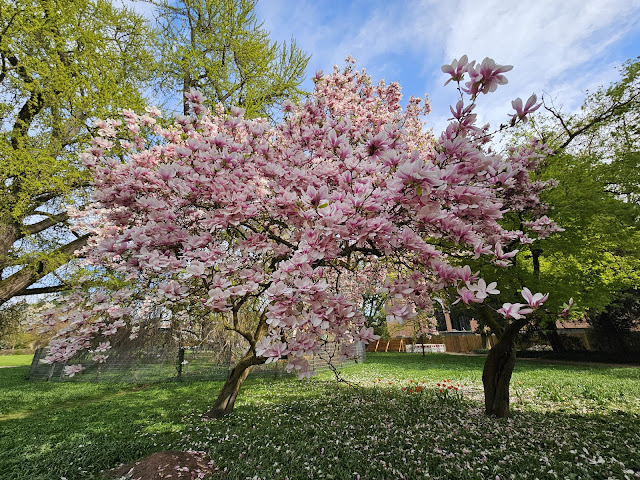













































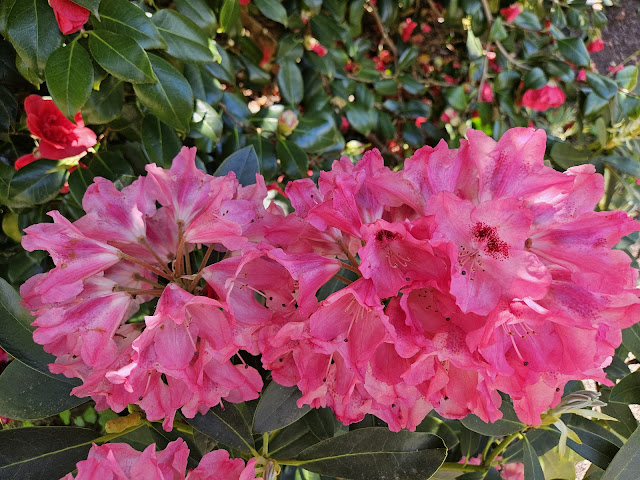



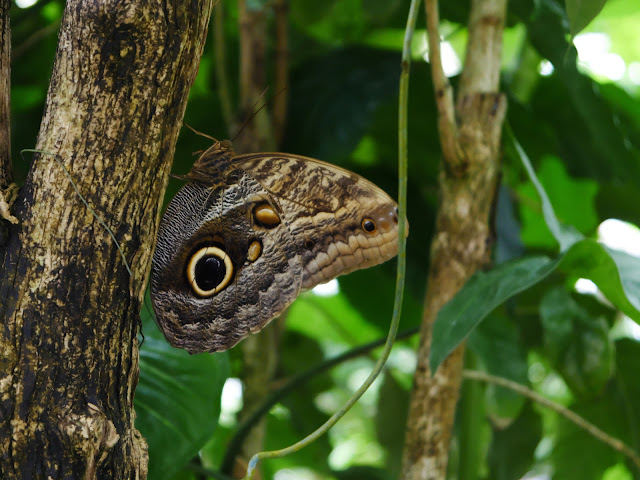































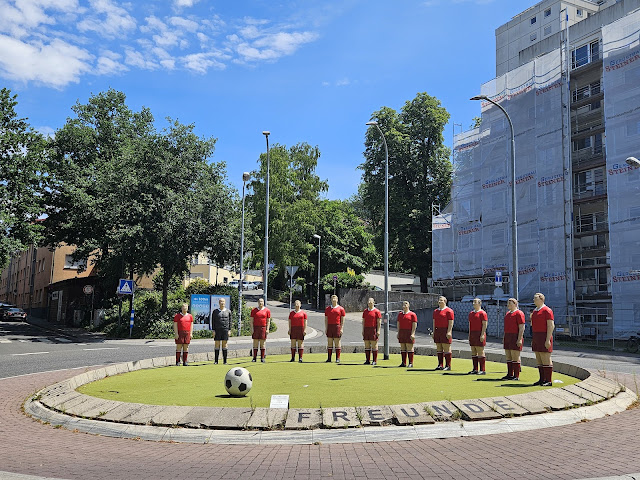












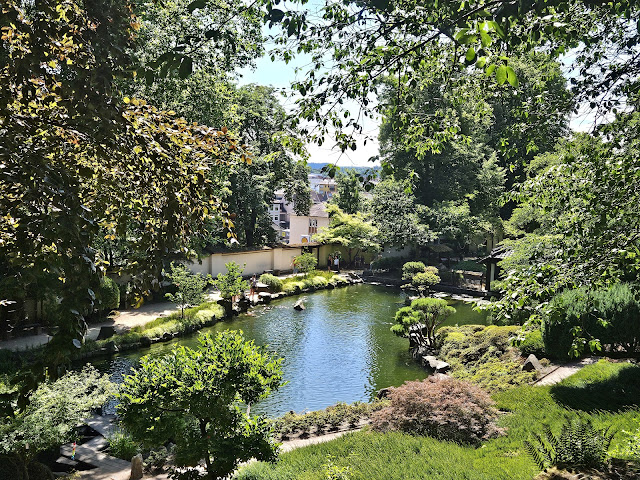






































































































































































































































































































































































































































Comments
Post a Comment